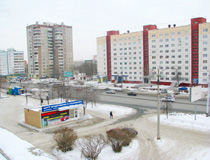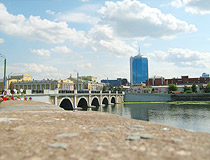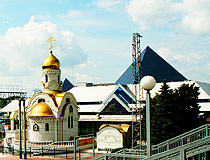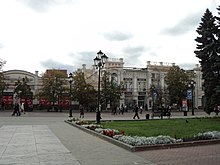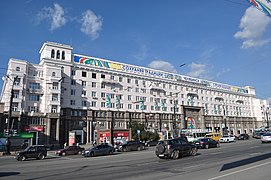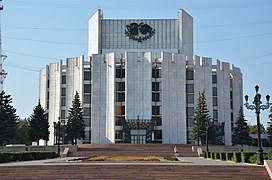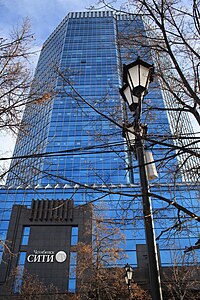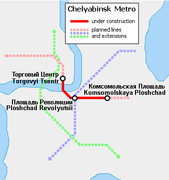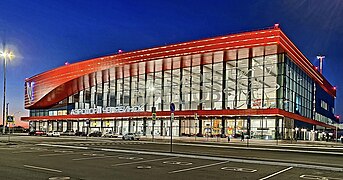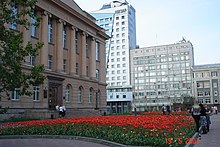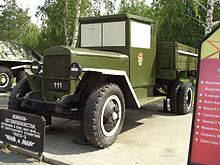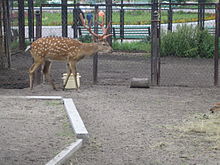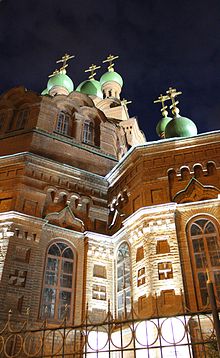There are many things to see in Chelyabinsk city. – Много всего можно увидеть в городе Челябинск.
For instance, Gagarin Park. It is a peaceful park area in the centre of Chelyabinsk city. – Например, парк Гагарина. Это тихая парковая зона в центре города Челябинска.
You can walk across Kirovka Pedestrian Street. This street is popular among tourists because of the beauty of the architecture, cafes and bars, great food, and beautiful atmosphere. – Вы можете прогуляться по пешеходной улице Кировка. Она пользуется популярностью среди туристов из-за красоты архитектуры, кафе и баров, вкусной еды и красивой атмосферы.
There are many museums such as Chelyabinsk Museum of Regional Studies, Museum of Labor and Fighting Glory, Museum of History of The Southern Ural Railroad and a lot of others. – Здесь есть много музеев таких как Челябинский краеведческий музей, Музей трудовой и боевой славы, Музей истории Южно-Уральской железной дороги и много других.
There is a beautiful Uvildy Lake. It is often called “a pearl of the South Urals”. The lake is unusual as it has many islands. – Здесь есть красивое озеро Увильды. Его часто называют “жемчужиной Южного Урала”. Озеро необычное, так как он имеет много островов.
You can see many churches in Chelyabinsk such as Alexander Nevsky Church, Holy Trinity Church, Saint George Church, Roman-Catholic Church, Saint Catherine Church and others. – Вы можете увидеть много церквей в Челябинске таких как церковь Александра Невского, церковь Святой Троицы, церковь святого Георгия, Римско-католическая церковь, храм в честь святой Екатерины и много других.
There is a great number of monuments, memorials, and sculptures in Chelyabinsk. For instance, monument to Kurchatov, Monument to Orlenok, Sculpture of The Postman, Memorial to Law and Order Soldiers, Monument to Soldiers-Internationalists, Sculpture the Firefighter, Monument To New Way and a lot of others. – В Челябинске есть большое количество памятников, мемориалов и скульптур. Например, памятник Курчатову, памятник “Орлёнок”, памятник почтальону, мемориал солдатам правопорядка, памятник воинам-интернационалистам, скульптура пожарный, памятник «На новый путь» и много других.
Also you can find Eternal Flame in Tsvillinga street in Chelyabinsk. It was lit in 1965 after the people who did not return from World War 2. – Также вы можете найти Вечный огонь на улице Цвиллинга в Челябинске. Он был зажжен в 1965 году в честь людей, которые не вернулись из Второй мировой войны.
Other attractions are Ice Arena Traktor, a big and new hokey arena; Red Communar Steam Train, a bit of Soviet history for those who are interested in industrial works of art; Decoratory-Landscape Composition Sphere of Love and others. – Другие достопримечательности: ледовая арена “Трактор”, большая и новая для хокею; провоз «Красный коммунар», немного советской истории для тех, кто заинтересован в промышленных произведениях искусства; декоративно-ландшафтная композиция Сфера любви и другие.
Here you will find a wide range of entertainment like cinemas, theatres, restaurants, and cafes. Many bank offices are near the city centre and close to city highways. – Здесь вы найдете широкий спектр развлечений, как кино, театры, рестораны и кафе. Многие банковские офисы находятся в центре города и недалеко от городских магистралей.
History of Chelyabinsk
Foundation of Chelyabinsk
In 1736, the fortress named Chelyaba (most likely, a Bashkir word) was founded on the Miass River. One of the reasons for the construction of this and several other fortresses located nearby was the threat of attacks of the Bashkirs on caravans with supplies. The fortress became part of the Ufa Province.
In 1748, the first stone church was laid in the fortress. In 1781, it received the status of a town called Chelyabinsk. In 1782, the coat of arms of Chelyabinsk was approved by decree of Empress Catherine II. A loaded camel depicted on it meant that trade routes passed through this town located in the Asian part of the Russian Empire. In 1795, the population of Chelyabinsk was about 2,700 people.
By the middle of the 19th century, this town played an important role in trading in the Urals. Until the end of the 19th century, Chelyabinsk remained a small town. In 1882, its population was about 7,700 people. The second birth of Chelyabinsk took place in 1892 — after the completion of the construction of the Samara-Zlatoust Railway, which connected Chelyabinsk with the European part of the Russian Empire.
After 1892, the construction of the Trans-Siberian Railway continued further to the east of the country. In 1896, the further development of Chelyabinsk was facilitated by the commissioning of the branch of the Ural Mining Railway, which connected Chelyabinsk with Yekaterinburg. In just a few years, the town became one of the leaders in bread, butter, meat, and tea trade in the Russian Empire. Chelyabinsk was unofficially called “The Gateway to Siberia”.
More historical facts…
Chelyabinsk in the first half of the 20th century
In just a decade, the population of the town grew significantly (in 1897 — about 20 thousand people, in 1910 — more than 60 thousand), and the territory increased by one third. For rapid growth at the turn of the 19th and 20th centuries, similar to American cities, Chelyabinsk was sometimes called “Chicago beyond the Urals”.
The armed rebellion of the Czechoslovak Corps after the events at the Chelyabinsk Railway Station on May 14, 1918 and the capture of the city on the night of May 26 to 27, 1918, led to its participation in the Civil War in Russia on the side of the Committee of Members of the Constituent Assembly and later on the side of A. V. Kolchak (one of the leaders of the White Armies opposing the Reds (Bolsheviks)). In July 1919, the Reds occupied Chelyabinsk and Bolshevik authorities began to form in the city. In 1923, the population of Chelyabinsk was about 54,300 people.
On September 3, 1919, Chelyabinsk became the center of the Chelyabinsk province. On November 3, 1924, it was transformed into the Chelyabinsk district of Ural Oblast. On January 17, 1934, Ural Oblast was divided into three separate regions — Sverdlovsk Oblast with a center in Sverdlovsk, Chelyabinsk Oblast with a center in Chelyabinsk, and Ob-Irtysh Oblast with a center in Tyumen.
In 1937, there were discussions about renaming the city of Chelyabinsk in Kaganovichgrad in honor of Lazar Kaganovich, a Soviet politician and administrator. During the first Soviet five-year plans, Chelyabinsk became one of the largest industrial centers of the USSR. From the beginning of the 1930s, tractor, abrasive, ferroalloy, electrode, machine tool, and zinc plants began to operate. In 1939, the population of Chelyabinsk was about 273,000 people.
Chelyabinsk during the Second World War
During the Second World War, Chelyabinsk played a very important role as a production base. The population of the city grew rapidly from 270 to 650 thousand people. On the basis of more than 200 enterprises evacuated from the western regions of the USSR that merged with local industries, several giant plants were opened: the Chelyabinsk Forge and Press Plant, the Chelyabinsk Metallurgical Plant, and the Chelyabinsk Pipe Rolling Plant.
After combining the capacities of the Chelyabinsk Tractor Plant with two evacuated enterprises — the Leningrad Kirov Plant and Kharkov Engine-Building Plant, mass production of tanks (KV-1, IS-2, T-34) and self-propelled guns (SU-152 and ISU-152) began. In total, during the war, about 60 thousand tank diesels and 18 thousand fighting vehicles (20% of all Soviet fighting vehicles) were produced in Chelyabinsk. By the end of the war, every third Soviet tank and combat aircraft had Chelyabinsk steel. The city acquired a new unofficial name — Tankograd (The City of Tanks).
During the war years, about 220,000 people were sent from the front to Chelyabinsk for treatment, 78% of them returned to service after healing their wounds. In 1941-1944, the Kiev Medical Institute, evacuated from the capital of Ukraine, was training medical doctors in Chelyabinsk. In 1944, the Chelyabinsk Medical Institute was established on its basis.
Chelyabinsk in the second half of the 20th century and beyond
In the post-war period, Chelyabinsk became a supplier of equipment, machinery, and specialists for the reconstruction of Stalingrad, Donbass, DneproGES, and other industrial centers. In 1947, a new development plan was approved, which provided for multi-storey buildings in the city center and areas adjacent to industrial enterprises. This radically changed the panorama of Chelyabinsk.
By 1960, there were already about 15 thousand students in Chelyabinsk. In 1976, Chelyabinsk State University was founded — the first classical university in the South Urals. By the 1980s, the capital of the South Urals became a major scientific center of the USSR with 7 universities and about 40 research and design institutes.
On October 13, 1976, a millionth resident was born in Chelyabinsk. By 1980, its enterprises produced more than 50% of Soviet stainless steel, 20% of pipes, 30% of ferroalloys. At this time, the new building of the Chelyabinsk Drama Theater with 1,200 seats was opened, the Chelyabinsk Puppet Theater gained all-Russian fame. In 1986, Chelyabinsk celebrated its 250th anniversary. In honor of this, a geological museum, a chamber and organ music hall were opened.
The first half of the 1990s, after the collapse of the USSR and the transition to a market economy, was a difficult time for Chelyabinsk and its huge plants. From the second half of the 1990s, industry gradually resumed production, and a lot of plants entered the world market.
In 2004, the pedestrian street of Kirovka was opened. It has become a favorite place for walks of Chelyabinsk residents and guests of the city. In 2006, the new building of the State Historical Museum of the South Urals was opened. In 2009, the ice arena “Tractor” with a capacity of 7,500 spectators was built. In the 2010s, after the recession of the 1990s, construction and commissioning of new housing intensified.
On February 15, 2013, a large meteor with a diameter of about 17 meters and a mass of about 10 thousand tons entered the atmosphere in the vicinity of Chelyabinsk (the Chelyabinsk Meteor). Fortunately, it exploded in the sky relatively high above the city. However, 7,320 buildings were damaged and 1,613 people were wounded as a result. Its debris fell into Lake Chebarkul, from where the largest fragment was later raised and delivered to the Chelyabinsk Museum of Local Lore.
Chelyabinsk views
Winter in a residential area in Chelyabinsk
Trinity Bridge in the center of Chelyabinsk
Author: Angelina Galimzyanova
Church of the Smolensk Icon of the Virgin near the Chelyabinsk Railway Station
Author: Aleksey Podbelsky
Chelyabinsk — Features
Chelyabinsk, one of the ten largest cities in Russia, is located almost in the center of the continent of Eurasia (about 1,400 km from its geographical center), east of the Ural Mountains, 216 km south of Yekaterinburg.
This city is located on the border of the Urals and Siberia. That is why it is also informally known as “The Gateway to Siberia”. At the turn of the 19th and 20th centuries, after the construction of the Trans-Siberian Railway, a lot of travelers bought postcards at the railway station of Chelyabinsk and sent them around the world as evidence of their stay in Siberia. Leningrad Bridge connects the Ural and Siberian banks of the Miass River, thus it is a bridge from the Urals to Siberia.
On the coat of arms of Chelyabinsk you can see a loaded camel, as a sign that important trade routes passed through it, and a fortress wall showing that Chelyabinsk was founded as a fortress.
The climate of Chelyabinsk is temperate continental (transitional from temperate continental to sharply continental). Winters are long, moderately cold, and snowy. The average temperature in January is minus 14.1 degrees Celsius. Summers are moderately warm and dry. The average temperature in July is plus 19.3 degrees Celsius.
Due to the fact that Chelyabinsk is an industrial city with a large number of factories, the environmental situation in the city is poor. The level of air pollution is high. The city has an increased level for a number of diseases compared with the average for Russia.
Chelyabinsk is one of the largest industrial centers of Russia. The main industries are metallurgy, manufacture of finished metal products, engineering. Chelyabinsk Electrometallurgical Plant is the largest ferroalloy plant in Russia. Chelyabinsk Zinc Plant produces about 2% of the world and 60% of Russian zinc. Chelyabinsk Metallurgical Plant is the largest producer of stainless steel in Russia.
Through Chelyabinsk, traffic flows from the European part of Russia to Siberia. In particular, this city is the final point of the federal highways M5 Ural (Moscow — Chelyabinsk), R254 Irtysh (Baikal) (Chelyabinsk — Novosibirsk), A310 (Chelyabinsk — Kazakhstan). Public transport is represented by buses, trolleybuses, trams, and minibuses. The international airport “Chelyabinsk” offers flights to several large Russian cities, mainly to Moscow and St. Petersburg.
Chelyabinsk has historically developed as a center of several cultures: first of all, the cultures of the indigenous inhabitants of the region — the Bashkirs, Tatars, and Russians. There are Orthodox churches and mosques, a Catholic church, several Protestant churches, and a synagogue in the city.
Main Attractions of Chelyabinsk
Kirovka Pedestrian Street — an analogue of the pedestrian street of Arbat in Moscow. Here you can see a number of interesting monuments (“Zero Milestone”, the monuments to volunteer tankers, Alexander Rosenbaum, the founders of Chelyabinsk), as well as sculptures (“The Boy with the Camels”, “The Artist at the Mirror Easel”, “The Saxophonist”, “The Coquette”, “The Beggar”, “The Merchant”, and others).
Also on this street there are shops, cafes, entertainment facilities, buildings of the early 20th century, and the business center “Chelyabinsk-City”.
Aloye Pole (Scarlet Field) — a park located in the very center of Chelyabinsk, one of its most popular holiday destinations. In the 19th century, it was a square where the city fair was held. In 1905, a demonstration of workers was dispersed by force here. That’s why the place got a new name — “Scarlet Square”. In 2000, the park received the status of a historical place.
Central Park of Culture and Rest named after Yury Gagarin. This park adjacent to the relict pine forest is the most beautiful park in Chelyabinsk with rides, sports grounds and playgrounds, a contact zoo, a summer movie theater. Fresh air, thick crowns of trees, blue expanse of ponds, comfort, and cleanliness attract residents and visitors of the city.
Chelyabinsk Zoo. On an area of 8 hectares, more than 130 species of animals live, of which more than 80 are listed in the Red Book including polar bears, Amur tigers, leopards. There is also a contact zoo on the territory, where children can also feed animals and play with them. Truda Street, 191.
Historical Museum of the Southern Urals. There are three permanent exhibitions dedicated to nature and ancient history, folklife, and history of the 20th century. The museum has old photographs, documents, books, paintings of the 18th-20th centuries, household items and clothing of Russians, nomads, and Tatar-Bashkir tribes, Zlatoust engravings, ancient coins, mineralogical collections, bones of extinct animals, and stuffed animals.
The museum also exhibits the largest (weighing half a ton) of the found fragments of the Chelyabinsk Meteor that exploded in the sky above the city at an altitude of about 15-25 km in 2013. Truda Street, 100.
Museum of Fine Arts. This museum has several thousand exhibits of Western European, Eastern, and Russian art. Here you can see the works of world-famous artists: Aivazovsky, Levitan, Shishkin. Also there is an interesting collection of icons of the 16th-19th centuries. Truda Street, 92a.
Museum of Arts and Crafts of the Urals. Here you can see the whole range of folk art crafts of the Southern Urals: products of the Zlatoust weapons factory, exhibits demonstrating the skill of local carvers and jewelers, hand-painted utensils, porcelain products of the South Ural factory, etc. Revolution Square, 1.
Chelyabinsk Railway Museum. The museum exposition is located in two places: in the building #63 on Tsvillinga Street, where more than 14 thousand exhibits are stored, and at the Chelyabinsk Railway Station (Zheleznodorozhnaya Street, 1/1), where you can see various railway equipment: steam locomotives, electric locomotives, modern trains, military trains, and special equipment. In the exhibition halls, you can see rails, station bells, old tickets, lights, signaling devices, and other items.
Museum of the Chelyabinsk Tractor Plant — the largest and most popular museum in the region. It is dedicated to the history and activities of the Chelyabinsk Tractor Plant. The museum has several thousand photographs, documents, personal belongings of employees, posters, newspaper clippings. It is better to visit this museum with a thematic tour, during which you can not only learn interesting facts, but also feel the true spirit of the plant and the city of Chelyabinsk. Lenina Avenue, 19.
Holy Trinity Church (1914) — the largest church in Chelyabinsk built of red brick and topped with a green roof. The main feature of this building is a large number of arched windows on all tiers and an abundance of decorative ornaments on the facade. Inside, the walls and ceiling are painted with murals on biblical themes. Kirova, 60?.
Monument to Kurchatov. Igor Kurchatov, the famous Soviet scientist and creator of the first atomic bomb in the USSR, was born in the town of Sim of Chelyabinsk Oblast in 1903. In 1986, in honor of the 250th anniversary of Chelyabinsk, the monument “Split Atom” was erected in his honor on Nauki (Science) Square. It consists of two vertical platforms 27 meters high, which symbolize an elementary particle, and the figure of Kurchatov standing in the middle. Lenina Avenue, 86.
This article is about a major city in Russia. For the town previously known as Chelyabinsk-40 and Chelyabinsk-65, see Ozyorsk, Chelyabinsk Oblast. For the town previously known as Chelyabinsk-50 and Chelyabinsk-70, see Snezhinsk.
|
Chelyabinsk Челябинск |
|
|---|---|
|
City[1] |
|
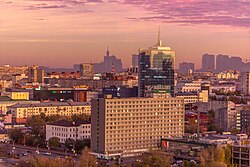 |
|
|
Flag Coat of arms |
|
|
Location of Chelyabinsk |
|
|
Chelyabinsk Location of Chelyabinsk Chelyabinsk Chelyabinsk (Chelyabinsk Oblast) |
|
| Coordinates: 55°09′17″N 61°22′33″E / 55.15472°N 61.37583°ECoordinates: 55°09′17″N 61°22′33″E / 55.15472°N 61.37583°E | |
| Country | Russia |
| Federal subject | Chelyabinsk Oblast |
| Founded | 1736[2] |
| City status since | 1787[2] |
| Government | |
| • Body | Council |
| • Head | Natalya Kotova (acting) |
| Area
[3] |
|
| • Total | 530 km2 (200 sq mi) |
| Elevation | 220 m (720 ft) |
| Population
(2010 Census)[4] |
|
| • Total | 1,130,132 |
| • Estimate
(2018)[5] |
1,202,371 (+6.4%) |
| • Rank | 9th in 2010 |
| • Density | 2,100/km2 (5,500/sq mi) |
|
Administrative status |
|
| • Subordinated to | City of Chelyabinsk[1] |
| • Capital of | Chelyabinsk Oblast[1], City of Chelyabinsk[1] |
|
Municipal status |
|
| • Urban okrug | Chelyabinsky Urban Okrug[1] |
| • Capital of | Chelyabinsky Urban Okrug[1] |
| Time zone | UTC+5 (MSK+2 |
| Postal code(s)[7] |
454xxx |
| Dialing code(s) | +7 351[8] |
| OKTMO ID | 75701000001 |
| City Day | September 13 |
| Website | www.cheladmin.ru |
Chelyabinsk (Russian: Челя́бинск, IPA: [tɕɪˈlʲæbʲɪnsk] (listen); Bashkir: Силәбе, Siläbe) is the administrative center and largest city of Chelyabinsk Oblast, Russia. It is the seventh-largest city in Russia, with a population of over 1.1 million people, and the second-largest city in the Ural Federal District, after Yekaterinburg. Chelyabinsk runs along the Miass River, and is just east of the Ural Mountains.
The area of Chelyabinsk contained the ancient settlement of Arkaim, which belonged to the Sintashta culture. In 1736, a fortress by the name of Chelyaba was founded on the site of a Bashkir village. Chelyabinsk was granted town status by 1787. Chelyabinsk began to grow rapidly by the early 20th century as a result of the construction of railway links from the Russian core to Siberia, including the Trans-Siberian Railway. Its population reached 70,000 by 1917. Under the Soviet Union, Chelyabinsk became a major industrial centre during the 1930s. The Chelyabinsk Tractor Plant was built in 1933. During World War II, the city was a major contributor to the manufacture of tanks and ammunition.
Chelyabinsk remains an important industrial centre, especially heavy industries such as metallurgy and military production. It is home to several educational institutions, mainly South Ural State University and Chelyabinsk State University.
History[edit]
Ancient Sintashta civilization[edit]
Archaeologists have discovered ruins of the ancient town of Arkaim in the vicinity of the city of Chelyabinsk. Ruins and artifacts in Arkaim and other sites in the region indicate a relatively advanced civilization existing in the area since the 2nd millennium BC, which was of proto-Indo-Iranian origin.[9]
The Arkaim site, located in the Sintashta-Petrovka cultural area, was known by Russian archaeologists for at least 70 years, however it was mostly ignored by non-Russian anthropological circles. The borders of the Sintashta-Petrovka cultural area run along the eastern Urals of the Eurasian steppe to about 400 km south of Chelyabinsk and to the east for about 200 km. 23 archaeological sites are recognized as being part of this area.
The sites resemble towns, laid out in round, square, or oval shapes. Although most of the sites have been discovered by aerial photography, only two, Arkaim and Sintashta, have been thoroughly excavated. These sites are characterized by their fortification, connected houses, and extensive evidence of metallurgy.[10]
The people of the Sintashta culture are thought to have spoken Proto-Indo-Iranian, the ancestor of the Indo-Iranian language family. This identification is based primarily on similarities between their language in comparison to sections of the Rigveda, and based on funerary rituals of the Sintashta culture, as revealed by archaeological studies in the area.[11][10]
Modern Russian history[edit]
The fortress of Chelyaba, from which the city takes its name, was founded at the location of the Bashkir village of Chelyaby (Bashkir: Силәбе, Siläbe) by colonel Alexey (Kutlu-Muhammed) Tevkelev in 1736[2] to protect the surrounding trade routes from possible attacks by Bashkir outlaws. During Pugachev’s Rebellion, the fortress withstood a siege by the rebel forces in 1774, but was eventually captured for several months in 1775. In 1782, Chelyabinsk became a seat of the uyezd of Ufa Viceroyalty, which was later reformed into Orenburg Governorate. In 1787, Chelyabinsk was granted town status by the government.
Kuznetsov’s tea-packing factory (1898)
Valeyev’s trading house (1911)
Until the late 19th century, Chelyabinsk was a small provincial town. In 1892, the Samara-Zlatoust Railway was completed, which connected it with Moscow and the rest of European Russia. Also in 1892, construction of the Trans-Siberian Railway started from Chelyabinsk, and in 1896, the city was linked to Ekaterinburg. Chelyabinsk then became the main hub for travel to Siberia. For fifteen years, more than fifteen million people — a tenth of Russia’s population at the time — passed through Chelyabinsk. Some of them remained in Chelyabinsk, which contributed to its rapid growth. In addition a so-called “customs fracture” was created in Chelyabinsk, which imposed duties on the shipment of goods between the European and Asian parts of Russia, which led to the emergence of mills and notably, a tea-packing factory. As a result, Chelyabinsk became a major trade center. Its population reached 20,000 inhabitants by 1897, 45,000 by 1913, and 70,000 by 1917. Because of its rapid growth at the turn of the 20th century, similar to that of midwestern American cities, Chelyabinsk was sometimes called «the Chicago of the Urals».[12]
During the first five-year plans of the 1930s, Chelyabinsk experienced rapid industrial growth. Several important factories, including the Chelyabinsk Tractor Plant and the Chelyabinsk Metallurgical Plant, were built at this time. During World War II, Joseph Stalin decided to move a large part of Soviet manufacturing to areas removed from the reach of the advancing German military as part of a general exodus from western occupied areas. This brought new industries and thousands of workers to Chelyabinsk, including facilities for the production of T-34 tanks and Katyusha rocket launchers. During World War II, the city’s industries produced 18,000 tanks and 48,500 tank diesel engines as well as over 17 million units of ammunition. During that time Chelyabinsk was informally called “Tankograd” (English: “Tank City”). During World War II, the S.M. Kirov Factory no. 185 or “OKMO” was moved to Chelyabinsk from Leningrad to produce heavy tanks, although it was transferred to Omsk after 1962.
2013 meteor[edit]
Shortly after dawn on February 15, 2013, a superbolide meteor descended at over 55,000 kilometers per hour (34,000 mph) over the Ural Mountains, exploding at an altitude of 25–30 kilometers (16–19 mi).[13]
The meteor created a momentary flash as bright as the sun and generated a shock wave that injured over a thousand people. Fragments fell in and around Chelyabinsk. Interior Ministry spokesman Vadim Kolesnikov said 1,100 people had called for medical assistance following the incident, mostly for treatment of injuries from broken glass by the explosions. One woman suffered a broken spine.[citation needed] Kolesnikov also said about 600 square meters (6,000 sq ft) of a roof at a zinc factory had collapsed. A spokeswoman for the Emergency Ministry told the Associated Press that there was a meteor shower; however, another ministry spokeswoman was quoted by the Interfax news agency as saying it was a single meteor.[14][15][16] The size has been estimated at 17 meters (56 ft) diameter with a mass of 10,000[17][18] or 11,000[19] metric tons. The power of the explosion was about 500 kilotons of TNT (about 1.8 PJ), which is 20–30 times more energy than was released from the atomic bomb detonated in Hiroshima. The city managed to avoid large casualties and destruction due to the high altitude of the explosion.
Administrative and municipal status[edit]
The building of the Legislative Assembly of Chelyabinsk Oblast
Chelyabinsk is the administrative center of the oblast.[1] Within the framework of administrative divisions, it is incorporated as the City of Chelyabinsk, an administrative unit with a status equal to that of the oblast’s districts.[1] As a municipal division, the City of Chelyabinsk is incorporated as Chelyabinsky Urban Okrug.[1] In June 2014, Chelyabinsk’s seven city districts were granted civil status.[20]
Administrative districts[edit]
Administrative districts of Chelyabinsk
Chelyabinsk is divided into seven administrative districts.
| No. | District | Population as of 2018[21] |
|---|---|---|
| 1 | Kalininsky | 224,391 |
| 2 | Kurchatovsky | 223,566 |
| 3 | Leninsky | 191,288 |
| 4 | Metallurgichesky | 138,156 |
| 5 | Sovetsky | 137,533 |
| 6 | Traktorozavodsky | 183,909 |
| 7 | Tsentral’ny | 100,015 |
Geography[edit]
Chelyabinsk is located east of the Ural Mountains, 200 km (100 miles) south of Yekaterinburg. It is elevated 200-250 meters (650′ to 825′) above sea level.
The city is bisected by the Miass River, which is regarded as the border between the Urals and Siberia. This is reflected in the geology of the area, with the granite foothills of the Ural Mountains to the west and the lower sedimentary rock of the West Siberian Plain to the east.
The Leningrad bridge crosses the river, due to this it is known as “the bridge between the Urals and Siberia». Chelyabinsk itself is also known as «the gateway to Siberia».[22]
Like Rome, Constantinople, San Francisco and Moscow, Chelyabinsk is said to be located on seven hills.[23]
Urban layout[edit]
The city of Chelyabinsk developed as a fortress. The first streets began to appear soon after the construction of the fortress on the right (southern) bank of the Miass River — already in September 1736. No residential buildings were built directly in the fortress itself; the houses of the inhabitants were located in the adjoining settlement, which was surrounded by a defensive wall. The very first street was formed between the northern wall of the fortress and the Miass River. A fragment of it is shown already in the foreground of the Chelyabinsk Fortress, attached by Colonel A.I. Tevkelev to his report to V.N. Tatishchev on September 10, 1736. Soon it received the name Sibirskaya (now Truda Street), since outside Chelyabinsk it crossed into the Siberian tract leading to Tobolsk. Apparently, there were also other names: in a number of sources it is called Bolshaya Beregovaya, as mentioned in a document dated March 10, 1753[24] The western end of the street in the last years of the 18th century acquired an independent name — on the pasture near the outskirts of the Ivanovo fair appeared.[25] Apparently, according to it, this part of the street began to be called Sibirskaya-Ivanovskaya (as it is called in the list of 1795). Then, already in the 19th century, it was a little later upstream and downstream of the Miass (that is, west and east of the fortress). Perpendicular to the river, several more streets were planned. At first there were four of them — two each on the western and eastern sides. The first street to the east got its name from the first Chelyabinsk church, consecrated in 1739 in honor of Nicholas the Wonderworker — Nikolaevskaya street (nowadays Sovetskaya). It was one-sided and went west towards the church and the fortress. After the Chelyabinsk fortress was assigned the status of the center of the Isetskaya province in 1743, the construction of administrative buildings began here, and another street was formed between Nikolaevskaya Street and the square with the church, ending in the south with the Orenburg Gate and continuing further after the then city limit by the road to Orenburg — Orenburgskaya (now Tsvillinga Street). On Orenburgskaya Street, in 1787 only four courtyards were counted, and in the list of 1795 it was already called Khristorozhdestvenskaya, and there were eleven courtyards on it. In the 18th and first half of the 19th century, Khristorozhdestvenskaya Street was the main street in the city, it was the place where its social and business life was concentrated. The urban planning on the territory of the historical center of Chelyabinsk almost without changes coincides with the plan of Chelyabinsk in 1838. The Chelyabinsk fortress was built in the center of this territory in 1736.[26] The plan of 1784 was supposed to streamline not only the layout of the city, but the development and maintenance of quarters. Along with the city center, a district center and a second city square are being laid in the riverside part. The plans of 1768 and 1784 were not carried out, though the existing Troitskaya Square, Truda Street and Tsvilinga Street are historical traces remained of them. In 1838, the land surveyor Sidorov drew up a new plan to streamline the city. In many ways, it was the starting point for the further development of the city.
By 1934, during the Soviet period and the mass industrialization, about 250 thousand people lived in the city. Large-scale urban planning tasks necessitated the development of the first master plan of the city, executed under the guidance of the architect N. G. Eismont in 1936 (Leningrad branch of Giprogor, architects N. G. Berlinerblau, S. M. Gotlib, N. V. Gromov, K. M. Zaichenko and A. M. Suborov). The estimated population according to the general plan of 1936 was to reach 550 thousand people. The city developed around the historical core, including by cutting down the island birch forest, in the planning of the central part, a rectangular grid of streets was preserved, but with the enlargement of quarters. The Metallurgichesky, Traktorozavodsky and Leninsky district were built and developed with heavy industry. Along with the city center, the centers of 5 administrative districts were planned, interconnected by a system of transport highways. The main street — Spartak Street (now Lenin Avenue) — appears as a link between the Traktorozavodsky district, Revolution Square and the future ensemble of the pre-park square. Historically developed streets of Kirov and Zwilling connected the main square of the city with the system of squares in Zarechye. The master plan of 1936 provided for the creation of urban recreation areas on the basis of Shershnevsky Bor and Lake Smolino, for the first time the issue of creating a large reservoir on the Miass River (Shershnevskoye reservoir) was raised.[27]
The war prevented the implementation of the master plan in full. The Chelyabinsk industrial complex has become a deep rear defense base of the country. The relocation of 60 industrial enterprises from the center of the country, the evacuation of the population were accompanied by mass construction of isolated villages from barracks and dugouts in free territories. At the same time, the urban area has grown significantly. The need to streamline the development of the post-war city is one of the driving reasons for the development of a new master plan, carried out in 1947 under the leadership of D. D. Bagarin (Lengiprogor, architects A. Slonimsky, L. Vertousov, engineers J. Rotenberg, I. Benevich and others). The second general plan is designed for a city with a population of more than 700 thousand people (in 1946, 450 thousand people lived in the city). Chelyabinsk was considered as a center of energy-intensive production, so the main attention was paid to the formation of 4 industrial hubs based on the capacities of existing enterprises.[28] The main architectural and planning idea was the unification of disparate parts of the city into a single organism — was transferred from the general plan of the pre-war period. Along with the territory of the districts that had reserves for development (Traktorozavodsky — towards Lake First, Metallurgical — with partial use of the territory of Kashtaksky Bor, Leninsky — to Lake Smolino), new sites for promising construction were envisaged (North-West and Churilovo). The issues of transport construction were actively resolved: the creation of a bypass ring highway connecting the city districts, the routing of the main highways from east to west (Pobedy Avenue, Khudyakov — Dzerzhinsky) and from north to south («Meridian» and Tchaikovsky Street) with access to the main roads beyond outside the city. In 1951, the master plan was adjusted in terms of the number of floors of the building: the share of multi-storey (up to 5 floors) buildings increased by reducing the share of 2-story and estate buildings to 25%.
The third master plan of the city (1967) was developed by the team of authors of the Chelyabinskgrazhdanproekt Institute. The city had a population of 857,000. The main architectural and planning idea was the active inclusion in the composition of the city of Shershnevsky and Kashtak forests, the Shershnevsky reservoir and the Miass River. Building on the free territories of the northwestern residential area, designed for a population of up to 300 thousand people, as a new direction for the development of the city, proposed by the master plan, has been carried out since the late 60s. The existing historically polycentric system of the center was enriched by the creation of new complexes: at the turn of the river near the Garden Island, along Tchaikovsky Street and the three-beam center of the northwest. The master plan of 1967 provided for the creation of new main streets and a ring road, the construction of bridges and overpasses, which was planned free the city center from transit traffic. In 1990 new city plan was approved and again in 2021.[29]
Climate[edit]
The city has a humid continental climate (Köppen: Dfb) similar to that of the Canadian prairies, despite being located further north. The average temperature in January is well below the freezing point at −14.9 °C or 5.2 °F. July has a relatively cool average of 19 °C or 66.2 °F, and the annual average is a few degrees above the freezing point at 3 °C or 37.4 °F, indicating some moderation. The range of extremes allegedly reaches 70 °C or 130 °F, claimed to be typical of a mid-latitude climate on a large continent such as Eurasia.[30]
The majority of precipitation occurs in the summer, with less in the winter. The month of July experiences the most, with an average 87 millimetres or 3.43 inches of precipitation, while January, the driest month, experiences 15 millimetres or 0.59 inches. Total precipitation reaches an average of 429 millimetres or 16.89 inches annually, consistent with the city’s semi-arid influence. On average, 119 days of the year experience precipitation.[30]
| Climate data for Chelyabinsk | |||||||||||||
|---|---|---|---|---|---|---|---|---|---|---|---|---|---|
| Month | Jan | Feb | Mar | Apr | May | Jun | Jul | Aug | Sep | Oct | Nov | Dec | Year |
| Record high °C (°F) | 4.9 (40.8) |
5.6 (42.1) |
19.9 (67.8) |
34.9 (94.8) |
39.9 (103.8) |
39.9 (103.8) |
39.9 (103.8) |
39.9 (103.8) |
34.9 (94.8) |
24.9 (76.8) |
14.9 (58.8) |
9.9 (49.8) |
39.9 (103.8) |
| Average high °C (°F) | −10.5 (13.1) |
−7.9 (17.8) |
1.0 (33.8) |
10.6 (51.1) |
20.3 (68.5) |
24.0 (75.2) |
25.2 (77.4) |
23.6 (74.5) |
17.2 (63.0) |
9.3 (48.7) |
−0.4 (31.3) |
−6.9 (19.6) |
8.8 (47.8) |
| Daily mean °C (°F) | −14.9 (5.2) |
−13.4 (7.9) |
−4.8 (23.4) |
4.7 (40.5) |
12.1 (53.8) |
18.3 (64.9) |
19.3 (66.7) |
17.1 (62.8) |
10.9 (51.6) |
4.1 (39.4) |
−5.2 (22.6) |
−11.1 (12.0) |
3.0 (37.4) |
| Average low °C (°F) | −19.0 (−2.2) |
−18.9 (−2.0) |
−9.3 (15.3) |
−0.3 (31.5) |
7.9 (46.2) |
12.9 (55.2) |
14.5 (58.1) |
13.5 (56.3) |
7.6 (45.7) |
1.3 (34.3) |
−5.9 (21.4) |
−14.6 (5.7) |
−0.9 (30.4) |
| Record low °C (°F) | −49.9 (−57.8) |
−44.9 (−48.8) |
−44.9 (−48.8) |
−29.9 (−21.8) |
−19.9 (−3.8) |
−4.9 (23.2) |
0.1 (32.2) |
0.1 (32.2) |
−9.9 (14.2) |
−24.9 (−12.8) |
−39.9 (−39.8) |
−44.9 (−48.8) |
−49.9 (−57.8) |
| Average precipitation mm (inches) | 17 (0.7) |
16 (0.6) |
19 (0.7) |
27 (1.1) |
47 (1.9) |
55 (2.2) |
87 (3.4) |
44 (1.7) |
41 (1.6) |
30 (1.2) |
26 (1.0) |
21 (0.8) |
430 (16.9) |
| Average rainy days | 0.1 | 0.3 | 4 | 10 | 15 | 19 | 17 | 16 | 16 | 10 | 6 | 1 | 114 |
| Average snowy days | 18 | 16 | 15 | 6 | 1 | 0.3 | 0 | 0 | 1 | 6 | 15 | 19 | 97 |
| Average relative humidity (%) | 85 | 77 | 76 | 66 | 61 | 64 | 69 | 71 | 73 | 73 | 82 | 83 | 73 |
| Source 1: Pogoda.ru.net[31] | |||||||||||||
| Source 2: World Meteorological Organization (precipitation days only)[32] |
Population[edit]
| Year | Pop. | ±% |
|---|---|---|
| 1897 | 20,000 | — |
| 1926 | 59,000 | +195.0% |
| 1939 | 273,116 | +362.9% |
| 1959 | 689,049 | +152.3% |
| 1970 | 875,210 | +27.0% |
| 1979 | 1,029,522 | +17.6% |
| 1989 | 1,141,777 | +10.9% |
| 2002 | 1,077,174 | −5.7% |
| 2010 | 1,130,132 | +4.9% |
| 2015 | 1,183,387 | +4.7% |
| 2020 | 1,196,680 | +1.1% |
As of 2020, the population of Chelyabinsk is 1,196,680; up from 1,130,132 recorded in the 2010 Census.[4]
At the time of the official 2010 Census, the ethnic makeup of the city’s population whose ethnicity was known (1,082,269) was:[33]
| Ethnicity | Population | Percentage |
|---|---|---|
| Russians | 936,457 | 86.5% |
| Tatars | 54,400 | 5.0% |
| Bashkirs | 33,716 | 3.1% |
| Ukrainians | 15,638 | 1.4% |
| Others | 42,058 | 3.9% |
Cityscape[edit]
Chelyabinsk skyline with the Miass River in the center.
Architecture[edit]
-
Historical residential building on Revolution square built in socialist classicism style (1938)
-
Aloye Pole Park
-
Chelyabinsk Drama Theater
The architecture of Chelyabinsk has been shaped through its history by the progression of historical eras in Russia. Before the 1917 Russian Revolution, the city was a trading center, with numerous merchant buildings in the eclectic and modern styles with elements of Russian Revival architecture, some of which are preserved on the pedestrian-only Kirovka Street.
Industrialization in Chelyabinsk started in the late 1920s. The construction of large plants was accompanied by the construction of new residential and public buildings in the constructivist style. Entire constructivist neighborhoods can be seen in the area of the Chelyabinsk Tractor Plant.[34]
In the late 1930s, a new era began in the city, with large-scale construction of Stalinist architecture. Many of the buildings in and around the city center and central avenue are constructed in this style.[35]
The next 60 years saw extensive construction of residential high-rise buildings as the city’s population rose to about one million, notably within the large residential area called «Severo-Zapad» (English: North-West).
With the market reforms of the 1990s, there was an increase in the construction of office buildings and major shopping malls in postmodern and high-tech styles.
Parks and gardens[edit]
Chelyabinsk has seventeen public parks. The largest is Gagarin Central Park.[36] Its territory includes large areas of rocky and forested terrain, located around several now-flooded abandoned quarries.
Education[edit]
South Ural State University
There are over a dozen universities in Chelyabinsk. The oldest, Chelyabinsk State Agroengineering Academy, was founded in 1930, followed by the Chelyabinsk State Pedagogical University in 1934. Major universities include South Ural State University, Chelyabinsk State University, South Ural State University of Arts, and Chelyabinsk Medical Academy. After World War II, Chelyabinsk became the main center of vocational education of the entire Ural region.[37]
Economy[edit]
Chelyabinsk-City Office Center, the tallest building in Chelyabinsk.
Chelyabinsk is one of the major industrial centers of Russia. Heavy industries, especially metallurgy and military production, are predominant in the area, notably the Chelyabinsk Metallurgical Combinate (CMK, ChMK), owned by the mining corporation Mechel. Other important industries include Chelyabinsk Tractor Plant (CTZ, ChTZ), Chelyabinsk Electrode Plant (ChEZ), the machine part-producing Chelyabinsk Forge-and-Press Plant (ChKPZ), the crane-producing Chelyabinsk Mechanical Plant (ChMZ), and Chelyabinsk Tube Rolling Plant (ChTPZ), which is included in the «Big Eight» of pipe producers in Russia, and produces large-diameter pipes for use in pipelines. Chelyabinsk Zinc Plant, owned by the Ural Mining and Metallurgical Company, produces about 2% of the world’s zinc supply and over 60% of the Russian supply. Kolyuschenko Road Machinery Plant produces construction machinery and dump trucks for the American manufacturer Terex.[38]
Molnija Watch Factory produces pocket watches, as well as technical watches for use in aircraft and ships. In 1980, Molnija watches were given as gifts to participants of the Moscow Olympic Games.[39]
The agro-industrial company Makfa, the largest producer of pasta in Russia, and one of the five largest producers in the world, is based in Chelyabinsk. The largest manufacturer of footwear in Russia, Unichel Footwear Firm, owns a factory in Chelyabinsk. Chelyabinsk is also home to the agricultural firm Ariant, which leads in the production of beverages and meat products in the Urals Federal District of Russia. The American corporation Emerson Electric owns part of the local company Metran, as well as a factory for the production of industrial equipment.[40]
In recent years, Chelyabinsk has had a significant role in other sectors of the Russian economy, hosting insurance firms, logistics centers, tourism, And important regional banking firms, such as Chelindbank and Chelyabinvestbank.
There are several large shopping malls. The largest of them are Gorky (English: Hills), built in 2007 with an area of 55,000 meters2 (13½ acres), and Rodnik (English: Spring) built in 2011 with an area 135,000 meters2 (33¼ acres). At least two more are under construction: Almaz (English: Diamond), and Cloud, beginning construction in 2015 and 2018, with planned areas of 220,000 and 350,000 meters2 (54¼ and 86½ acres), respectively.
Transportation[edit]
-
Tram and trolleybus in Chelyabinsk
-
Planned metro network
-
-
Chelyabinsk railway Station
-
Public transport in Chelyabinsk consists of bus (since 1925), tram (since 1932) and trolleybus (since 1942) networks, as well as private marshrutka (routed cab) services. The city has several taxi companies.
In 2014 in Chelyabinsk began to run electric buses, trolleybuses fitted to run electrically.[41]
In 2011 the telecommunications company Beeline and Chelyabinsk city transport signed an agreement to provide passengers free internet. Currently Wi-Fi is available in some public trams and trolleybuses in Chelyabinsk.
Chelyabinsk started the construction of a three-line subway network in 1992.[42]
The city is served by the Chelyabinsk Airport.
Sports[edit]
-
Traktor Arena
-
-
-
Several sports clubs are active in the city:
| Club | Sport | Founded | Current League | League Rank |
Stadium |
|---|---|---|---|---|---|
| Traktor Chelyabinsk | Ice Hockey | 1947 | Kontinental Hockey League | 1st | Traktor Arena |
| Chelmet Chelyabinsk | Ice Hockey | 1948 | Higher Hockey League | 2nd | Yunost Sports Palace |
| Belye Medvedi Chelyabinsk | Ice Hockey | 2009 | Junior Hockey League | Jr. 1st | Traktor Arena |
| FC Chelyabinsk | Football | 1977 | Russian Second Division | 3rd | Central Stadium |
| Sintur Chelyabinsk | Futsal | 1997 | Futsal Supreme League | 2nd | USURT Sports Complex |
| Dynamo-Metar Chelyabinsk | Volleyball | 1972 | Women’s Volleyball Superleague | 1st | Metar-Sport Sports Palace |
| Dynamo Chelyabinsk | Volleyball | 1986 | Men’s Volleyball Supreme League | 2nd | Metar-Sport Sports Palace |
In recent history, Chelyabinsk has hosted several important sporting events, especially in martial arts. These events include the 2012 European Judo Championships, the 2014 World Judo Championships, and the 2015 World Taekwondo Championships. 2015 also saw Chelyabinsk host the European Speed Skating Championships. In 2018, Chelyabinsk and nearby Magnitogorsk hosted the IIHF World U18 Championship.
Culture[edit]
Chelyabinsk Regional Universal Scientific Library
The city has several libraries, notably Chelyabinsk Regional Universal Scientific Library, the largest public library in the Chelyabinsk Oblast. The library has more than 2 million books, over 12,000 of which are rare, originating from the 17th to 19th centuries.
Nahum Orlov State Academic Drama Theater
Chelyabinsk is home to several theatres. The Chelyabinsk Opera and Ballet Theatre, also known as the Glinka State Academic Opera and Ballet Theatre, was built in 1936–55 on the site of the former Nativity Cathedral, which existed from 1748 to 1932. The opening of the theatre eventually took place on September 29, 1956, with a production of Alexander Borodin’s «Prince Igor».[43] Others include the Nahum Orlov State Academic Drama Theatre, Chelyabinsk State Chamber Theater, Chelyabinsk State Puppet Theater, Chelyabinsk State Youth Theatre, Mannequin Theater, Chelyabinsk New Arts Theatre, and Chelyabinsk Contemporary Dance Theatre.
Concert Hall of the Glinka State Academic Opera and Ballet Theatre
Chelyabinsk regional museum
There are nine museums in Chelyabinsk. Chelyabinsk Regional Museum was founded in 1913 and holds about 300,000 exhibits. Important expositions include the «Land of Cities» exhibit relating to the 2nd and 3rd millennium BCE settlement of Arkaim, the 570 kg largest fragment of the Chelyabinsk meteor, ornate 19th and 20th century blades made by Zlatoust arms factory, exhibits of Kasli artistic cast iron, and much more.
Chelyabinsk Regional Picture Gallery has more than 11,000 works. The museum displays collections of Russian, European, and international works originating from the Middle Ages to modern times. The museum has significant collections of religious icons from the 16th to 20th centuries, along with early printed books and manuscripts.
The Museum of History of the Southern Ural Railway hosts more than 30 exhibits of equipment used on the railway after its opening in Chelyabinsk in 1892.
Museum of Military Equipment in the Garden of Victory
Holy Trinity Church (1914)
The Museum of Military Equipment in the Garden of Victory was founded in 2007. It has 16 exhibits, including models of T-34 and IS-3 tanks, along with Katyusha rocket launchers produced in Chelyabinsk during World War II.
In addition, the city is home to the Chelyabinsk Regional Geological Museum, the Malgobekskii Museum of Military and Labor Glory, the Chelyabinsk Postal Service Museum, and the Entertaining Sciences Museum Eksperimentus.
Chelyabinsk Zoo is located in the central region of Chelyabinsk. It has an area of 30 hectares (75 acres) with more than 110 species of animals, of which more than 80 are listed in the Red Data Book of the Russian Federation. The zoo participates in international programs for the conservation of endangered species, including amur (siberian) tigers, far eastern leopards and polar bears. The zoo holds regular sightseeing tours, lectures, exhibitions and celebrations.
Other cultural attractions include the Chelyabinsk State Circus, the Chelyabinsk State Philharmonic Concert Hall named after Sergei Prokofiev, and Organ and Chamber Music Hall Rodina.
Chelyabinsk is home to several churches built from the 19th to 21st centuries.
Notable people[edit]
- Ariel, Soviet pop rock band
- Lera Auerbach (born 1973), composer and musician, born and grew up in Chelyabinsk
- Svyatoslav Belza (1942–2014), musical scholar, critic and essayist, born in Chelyabinsk
- Anatoliy Kroll [ru] (born 1943), jazz musician, bandleader, composer, born and started his career in Chelyabinsk
- Zhan Bush (born 1993), figure skater
- Dmitry Shishkin born in 1992 Classical Pianist
- Yekaterina Gamova (born 1980), Olympic volleyball player, born and grew up in Chelyabinsk
- Makhmut Gareev (1923–2019), historian and military scientist, born and grew up in Chelyabinsk
- Sidney Gordin (1918–1996), artist, professor
- Viktor Khristenko (born 1957), politician and statesman born and grew up in Chelyabinsk
- Igor Kurnosov (1985–2013), chess grandmaster, born in Chelyabinsk
- Oleg Mityaev (born 1956), singer-songwriter and actor, born, grew up, and came into prominence in Chelyabinsk
- Vadim Muntagirov (born 1990), ballet dancer, born in Chelyabinsk
- Staņislavs Olijars (born 1979), Latvian 110m hurdler, gold medallist at the 2006 European Athletics Championships, born in Chelyabinsk
- Georgy Ratner (1923–2001), surgeon, born in Chelyabinsk
- Nelli Rokita (born 1957), Polish politician, born in Chelyabinsk
- Eugene Roshal (born 1972), software developer, born in Chelyabinsk
- Mariya Savinova (born 1985), Olympic athlete, born in Chelyabinsk
- Galina Starovoytova (1946–1998), politician and human rights activist, born in Chelyabinsk
- Maksim Surayev (born 1972), cosmonaut, born in Chelyabinsk
- Evgeny Sveshnikov (born 1950), chess grandmaster and writer, born and grew up in Chelyabinsk
- Anna Trebunskaya (born 1980), ballroom and Latin dancer, born in Chelyabinsk
- Ivan Ukhov (born 1986), Olympic high jumper, born in Chelyabinsk
- Mikhail Yurevich (born 1969), businessman, politician, born in Chelyabinsk
- Mikhail Koklyaev (born 1978), Russian strongman competitor
Ice hockey players[edit]
- Sergei Babinov (born 1955), Soviet player, Canada Cup champion
- Sergei Starikov (born 1958), Soviet Olympian and NHL player
- Vyacheslav Bykov (born 1960), Soviet player
- Stanislav Chistov (born 1983), NHL and KHL player
- Evgeny Davydov (born 1967), NHL player, USSR champion
- Sergei Gonchar (born 1974), NHL player, Stanley Cup champion
- Dmitri Kalinin (born 1980), NHL and KHL player, Gagarin Cup champion
- Alexandra Vafina (born 1990), Russian Olympic ice hockey player (2010, 2014)
- Evgeny Kuznetsov (born 1992), NHL and KHL player, Stanley Cup champion
- Sergei Makarov (born 1958), NHL player
- Andrei Nazarov (born 1974), NHL player and KHL coach
- Nikita Nesterov (born 1993), NHL and KHL player
- Valeri Nichushkin (born 1995), NHL and KHL player, Stanley Cup champion
- Valeri Karpov (1971–2014), Russian Superleague and NHL player
- Dmitri Tertyshny (1976–1999), Russian Superleague and NHL player
- Slava Voynov (born 1990), NHL player, Stanley Cup champion
- Danil Yerdakov (born 1989), KHL player
- Danis Zaripov (born 1981), KHL player, Gagarin Cup champion
- Yakov Trenin (born 1997), NHL player
International relations[edit]
Twin towns – sister cities[edit]
Chelyabinsk is twinned with:[44]
Diplomatic and consular missions and visa centers[edit]
See also[edit]
- Chelyabinsk Trade Center
References[edit]
Notes[edit]
- ^ a b c d e f g h i Resolution #161
- ^ a b c «Chelyabinsk — Russia». Retrieved September 21, 2017.
- ^ «Челябинск сегодня – Визитная Карточка». Администрация г. Челябинска. Archived from the original on January 26, 2012.
- ^ a b Russian Federal State Statistics Service (2011). Всероссийская перепись населения 2010 года. Том 1 [2010 All-Russian Population Census, vol. 1]. Всероссийская перепись населения 2010 года [2010 All-Russia Population Census] (in Russian). Federal State Statistics Service.
- ^ «26. Численность постоянного населения Российской Федерации по муниципальным образованиям на 1 января 2018 года». Federal State Statistics Service. Retrieved January 23, 2019.
- ^ «Об исчислении времени». Официальный интернет-портал правовой информации (in Russian). June 3, 2011. Retrieved January 19, 2019.
- ^ «Information about central postal office» (in Russian). Archived from the original on March 3, 2016.
- ^ «Russian Federation Cities dialing codes» (ZIP 34.4KB) (in Russian).[permanent dead link]
- ^ «Ancient Aryan civilization achieved incredible technological progress 40 centuries ago». Pravda. July 16, 2005.
- ^ a b Basu, Dipak (2017). India as an Organization: Volume One. Palgrave Macmillan. p. 23. ISBN 978-3-319-53372-8.
- ^ Anthony 2007, pp. 408–411.
- ^ «Челябинск: Ворота в Сибирь и Зауральский Чикаго». Портал Челябинская область. Archived from the original on April 18, 2011. Retrieved July 6, 2014.
- ^ Campbell-Brown, Margaret. «What Do We Know about the Russian Meteor? Meteor researcher Margaret Campbell-Brown recaps the latest research into the cause of this morning’s fireball over Chelyabinsk». Scientific American (Interview). Interviewed by John Matson. Retrieved December 24, 2017.
[Interviewer:] Where was most of the energy released as this object made its way through the atmosphere? [Subject:]In this case the final destination, which seems to have been the largest deposit of energy, was somewhere around 15 to 20 kilometers altitude. The actual fireball probably started significantly higher than that, maybe 50 kilometers, but most of the energy was apparently deposited during that last explosion lower in the atmosphere.
- ^ Plait, Phil (February 15, 2013). «Breaking: Huge Meteor Blazes Across Sky Over Russia; Sonic Boom Shatters Windows [UPDATED]». Slate. Retrieved February 15, 2013.
- ^ «Meteor strikes Earth in Russia’s Urals». Pravda. February 15, 2013. Retrieved February 15, 2013.
- ^ «400 Injured by Meteorite Falls in Russian Urals». Associated Press. Retrieved February 15, 2013.
- ^ Agle, D. C. (February 13, 2013). «Russia Meteor not Linked to Asteroid Flyby». NASA news. NASA. Retrieved February 15, 2013.
- ^ Sreeja, VN (March 4, 2013). «New Asteroid ‘2013 EC’ Similar To Russian Meteor To Pass Earth At A Distance Less Than Moon’s Orbit». International Business Times. Retrieved March 9, 2013.
- ^ Yeomans, Don; Chodas, Paul (March 1, 2013). «Additional Details on the Large Fireball Event over Russia on Feb. 15, 2013». NASA/JPL Near-Earth Object Program Office. Archived from the original on March 6, 2013. Retrieved March 2, 2013.
- ^ Law #706-ZO
- ^ «Численность населения Российской Федерации по муниципальным образованиям на 1 января 2020 года» (in Russian). Rosstat. Retrieved October 17, 2020.
- ^ История Челябинска — от крепости до железнодорожной станции (in Russian). Портал Челябинская область. Archived from the original on March 31, 2008. Retrieved July 6, 2014.
- ^ «Холмы Челябинска». Электронное периодическое издание Mediazavod.ru. Archived from the original on July 14, 2014. Retrieved July 9, 2014.
- ^ Улицы Челябинска XVIII века: прогулка по городу
- ^ то мы знаем об историческом облике столицы Южного Урала?, Missayski Rabochi
- ^ Исторический центр Челябинска. Часть 1. Улица Васенко
- ^ Chelyabinsk General Plan, O. Shelnikov
- ^ Chelyabinsk General Plan, O. Shelnikov
- ^ В Челябинске утверждают новый генплан на 20 лет
- ^ a b «Chelyabinsk, Russia Köppen Climate Classification (Weatherbase)». Weatherbase. Retrieved November 13, 2018.
- ^ «Weather and Climate (Погода и Климат – Климат Челябинска)» (in Russian). Pogoda.ru.net. Archived from the original on April 16, 2013. Retrieved December 13, 2012.
- ^ «World Weather Information Service – Cheljabinsk». World Meteorological Organization. Archived from the original on November 17, 2018. Retrieved December 13, 2012.
- ^ «Наиболее многочисленные национальности» (PDF). Rosstat. Archived from the original (PDF) on August 22, 2016. Retrieved September 11, 2016.
- ^ Конструктивизм в архитектуре Челябинска (in Russian). April 27, 2009.
- ^ «Сталинский ампир». January 16, 2016.
- ^ «Парк Гагарина в Челябинске попал в топ-5 лучших в России».
- ^ «На Урале».
- ^ «В Челябинске начали производство 100-тонных самосвалов».
- ^ «Часовой завод «Молния»«. Archived from the original on July 11, 2014. Retrieved July 9, 2014.
- ^ «Вице-президент Emerson Process Management в Восточной Европе: «В Челябинске есть свой маленький центр «Сколково»«. December 5, 2014.
- ^ «В Челябинске начал курсировать электробус».
- ^ «Chelyabinsk». UrbanRail.net. Archived from the original on May 17, 2013. Retrieved January 31, 2014.
- ^ «История театра». Chelopera.ru (in Russian). Retrieved October 12, 2022.
- ^ «Города-побратимы». cheladmin.ru (in Russian). Chelyabinsk. Retrieved February 3, 2020.
- ^ www.pinstudio.ru. «Филиалы — Visa Management Service». www.italyvms.ru. Retrieved September 21, 2017.
- ^ «La rete consolare». www.ambmosca.esteri.it. Retrieved September 21, 2017.
Sources[edit]
- Anthony, David W. (2007). The Horse, the Wheel, and Language. Princeton, NJ: Princeton University Press. ISBN 978-0-691-05887-0.
- Законодательное Собрание Челябинской области. Постановление №161 от 25 мая 2006 г. «Об утверждении перечня муниципальных образований (административно-территориальных единиц) Челябинской области и населённых пунктов, входящих в их состав», в ред. Постановления №2255 от 23 октября 2014 г. «О внесении изменений в перечень муниципальных образований (административно-территориальных единиц) Челябинской области и населённых пунктов, входящих в их состав». Вступил в силу со дня официального опубликования. Опубликован: «Южноуральская панорама», №111–112, 14 июня 2006 г. (Legislative Assembly of Chelyabinsk Oblast. Resolution #161 of November 25, 2006 On Adoption of the Registry of the Municipal Formations (Administrative-Territorial Units) of Chelyabinsk Oblast and of the Inhabited Localities They Comprise, as amended by the Resolution #2255 of October 23, 2014 On Amending the Registry of the Municipal Formations (Administrative-Territorial Units) of Chelyabinsk Oblast and of the Inhabited Localities They Comprise. Effective as of the official publication date.).
- Законодательное Собрание Челябинской области. Закон №706-ЗО от 10 июня 2014 г. «О статусе и границах Челябинского городского округа и внутригородских районов в его составе». Вступил в силу со дня официального опубликования. Опубликован: «Южноуральская панорама», №87 (спецвыпуск №24), 14 июня 2014 г. (Legislative Assembly of Chelyabinsk Oblast. Law #706-ZO of June 10, 2014 On the Status and Borders of Chelyabinsky Urban Okrug and the City Districts It Comprises. Effective as of the day of the official publication.).
- Anne Garrels, Putin Country: A Journey Into The Real Russia (New York: Farrar, Straus and Giroux, 2016).
- Lennart Samuelson, Tankograd: The Formation of a Soviet Company Town: Cheliabinsk, 1900s–1950s (Basingstoke, Palgrave Macmillan, 2011).
External links[edit]
- Official website of Chelyabinsk
- Chelyabinsk Business Directory (in Russian)
- Chelyabinsk News Agency (in Russian)
- Chisholm, Hugh, ed. (1911). «Chelyabinsk» . Encyclopædia Britannica (11th ed.). Cambridge University Press.
- Interactive book about Chelyabinsk in iBooks Store
Chelyabinsk is the administrative center of Chelyabinsk Oblast (region) and seventh among Russian cities with a population over a million. It is located in the center of Eurasia, on the eastern slope of the Ural Mountains, 1,879 km away from Moscow.
City of Metallurgists
Russians have many jokes about Chelyabinsk, which imply that its inhabitants are rather rough. This is not surprising, as many people there work in production, since Chelyabinsk is a major industrial center, including metallurgy, machinery manufacturing and metalworking, instrument manufacturing, and chemical, light and food industries. However, the primary product of the city is metal (high-quality alloys and stainless steel), including zinc and various heavy machinery and pipes. Today, the city has about 150 large plants.
City between Siberia and Europe
It is interesting to note that, from the geological point of view, half of Chelyabinsk is located in Siberia, since it stands on sedimentary rocks, while the other half stands on the granite typical for the Urals. The two parts are divided by the Miass River and connected by Leningradsky Bridge, which may be used by residents to travel from Europe to Siberia and back several times a day.
Modern City
Chelyabinsk was founded in 1736 at the site of the Cossack fortress Chelyaba. Chelyabinsk’s coat of arms bears a camel to remind that a trade route to India once passed through the city. Today, ancient buildings remain in the center only, and there are cobbled pedestrian streets. The rest of Chelyabinsk has Soviet-era buildings, though there are also modern business and shopping centers, hotels, and high-rises.
Green City
In spite of Chelyabinsk primarily being an industrial city, it has many parks and much landscaping. For example, a real forest is located right in the center of the city and forms part of Gagarin Central Recreation Park. One more popular place in the city is Aloye Pole (Scarlet Field) Park with hundreds of red tulips blossoming in spring.
City of Culture
Residents of Chelyabinsk not only work hard, but also enjoy culture. There are many museums, such as the Geological Museum containing samples of all minerals produced in the Urals. The city has a philharmonic orchestra, a circus, a jazz center, an opera house and a drama theater. Annually, Chelyabinsk hosts various cultural events, such as the Kamerata Chamber Theater Festival and International Organ Festival. In summer, the amateur singer festival gathers performers from all of Russia on the banks of Lake Ilmen in Chelyabinsk Oblast. In autumn, the «Incorrect Cinema» Festival screens art house films.
City of Sports
The city hosts various sports events, such as the 2012 European Judo Championship, when its guests praised the high level of organization. Also, Chelyabinsk has a tradition of conducting a New Years sports training session for youth. During this, high school and university students compete in six street sports.
City Where a Meteorite Fell
In 2013, the world heard the news of the meteorite (more precisely, only fragments of it) falling on Chelyabinsk. The impact was accompanied by a series of explosions which caused broken windows in several houses. This happened on February 15 and attracted much attention to the city. However, what amazed the world most was the reaction of the Chelyabinsk inhabitants – instead of running away in fear, many rushed right toward the meteorite, using their phones to shoot videos of the impact and commenting.
Описание (английский)
Chelyabinsk is a city and the administrative center of Chelyabinsk Oblast, Russia, located in the northeast of the oblast, 210 kilometers (130 mi) south of Yekaterinburg, just to the east of the Ural Mountains, on the Miass River, on the border of Europe and Asia.
The architecture of the Chelyabinsk is determined by the change of historical eras in the development of Russia. Before the revolution of 1917 the city was a trading centre, with numerous merchant buildings in style eclecticism and modern with elements Russian Revival architecture, they are stored on a pedestrian street Chelyabinsk “Kirovka”.
From the late ’20s industrialization
started. The construction of large plants was accompanied by the
construction of a brand new residential and public buildings in the
style of constructivism. Entire neighborhoods built in the style of constructivism can be seen in the area of the Chelyabinsk Tractor Plant (CTZ, ChTZ).
Since the late ’30s in the city came a new era associated with construction of monumental buildings in the Stalinist architecture. It is in this style is constructed in substantially the center of the city of Chelyabinsk and central avenue.
With 60 years in the city was conducted intensive housing construction tower blocks.
During this period the city had reached a population of one million
people, and on his map there is such a large residential area as the
«Severo-Zapad» (English: North-West).
Since the ’90s, market reforms, the city began an intensive
construction of office buildings for business and major shopping malls
in style postmodern architecture and high-tech.
Chelyabinsk has 17 public parks. The largest of them is one of the best in Russia — Chelyabinsk Central Park, named after Gagarin.
Its territory is saved in the urban forest, where, among pine trees and
granite rocks there are several picturesque ex-quarries now flooded
with water.

